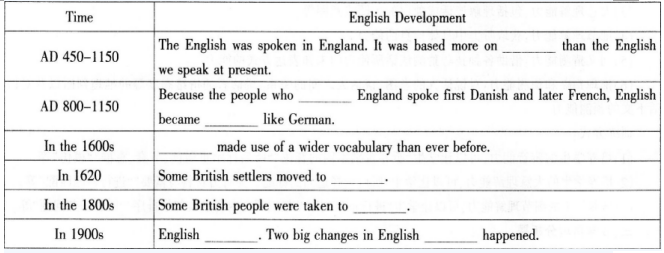当前位置:首页 → 职业资格 → 教师资格 → 中学英语学科知识与教学能力->根据提供的信息和语言素材设计教学方案,用英文作答。设计任务:
根据提供的信息和语言素材设计教学方案,用英文作答。
设计任务:请阅读下面学生信息和语言素材.设计一个25分钟的阅读训练活动。
教案没有固定格式.但须包含下列要点:
teaching objectives
teaching contents
key and difficult points
major steps and time allocation
activities and justifications
教学时间:25分钟
学生概况:某城镇普通中学高中一年级学生,班级人数40人。多数学生已经达到《普通高中英语课程标准(实验)》五级水平。学生课堂参与积极性一般。
语言素材:
The Road to Modern English
At the end of the 16th century, above five to seven million people spoke English. Nearly all of them lived in England. Later in the next century, people from England made voyages to conquer other parts of the world and because of that, English began to be spoken in many other countries.
Today, more people speak English as their first, second or a foreign language than ever before.
Native English speakers can understand each other even if they don't speak the same kind of English. Look at this example:
British Betty: Would you like to see my flat?
American Amy: Yes, I'd like to come up to your apartment.
So why has English changed over time? Actually all languages change and develop when cultures meet and communicate with each other. At first, the English language spoken in England between about AD 450 and 1150 was very different from the English spoken today. It was based more on German than the English we speak at present. Then gradually between about AD 800 and1150, English became less like German because those who ruled England spoke first Danish and later French. These new settlers enriched the English language and especially its vocabulary. So by the 1600s Shakespeare was able to make use of a wider vocabulary than ever before. In 1620 some British settlers moved to America. Later in the 18th century some British people were taken to Australia too. English began to speak in both countries.
Finally by the 19th century the language was settled. At that time two big changes in English spelling happened: first Samuel Johnson wrote his diction
Class Type: Reading class
Teaching Contents: The Road to Modern English
Teaching Objectives:
(1) Knowledge objective
Students can learn the development of English and the reasons that English has changed over time.
(2) Ability objective
Students can master predict the content of the text according to the tide and improve their reading abilities through the process of skimming and scanning.
(3) Emotional objective
Students can have a deeper impression of the popularity of English, realize the importance of learning English and have a higher motivation to learn it.
Teaching Key and Difficult Points:
How to make students predict before reading, get the general idea and the specific information while reading.
Major Steps:
Step 1 Pre-reading (6 minutes)
Activity 1 Guessing game
The teacher asks students to guess the meanings of the sentences which are written in old English.
As fair art thou, my bonnie lass,
So deep in luve am I;
And I will luve thee still, my dear,
Till a' the seas gang dry.
Then the teacher explains the background knowledge of the sentences.
(Justification: The guessing game can arouse students' interest in the topic and activate the class attnosphere.
Students will realize that the old English is different from modern English when talking about the meaning of these sentences written in old English, which will get them mentally prepared for the reading comprehension.)
Activity 2 Prediction
Ask students to make a prediction according to the title of the text.
(Justification: Students' predictions will get their mind closer to the theme of the text to be read and make their reading more intriguing and purposeful.)
Step 2 While-reading (12 minutes)
Activity I Skimming
The teacher asks students to read the text, check if they have made the right predictions and try to match the general idea of each paragraph.
Choose one or two groups to show their understanding, give comments and make a summary:
Paragraph 1Many people all over the world speak English.
Paragraph 2Why has English changed over time?
Paragraph 3English is now spoken in South Asia.
Paragraph 4Native speakers can understand each other even if they don' t speak the same kind of English.
Paragraph 5Finally by the 19th centurythe language was settled.
Then the teacher checks the answers.
(Justification: This step will help students confirm or reject their predictions and get the main idea of the text.)
Activity 2 Filling in the blanks
The teacher asks students listen to the recording of the text, underline the phrases that have something to do with the time and then fill in the form.

Then the teacher checks the answers.
(Justification: In the process of filling the form, students' reading skill of scanning for the detailed information will be improved, and it will help student understand the text logically.)
Step 3 Post-reading (7 minutes)
Activity 1 Retelling
T: Suppose you are an English teacher, and you have to give a brief introduction of the development of modern English to your students.
Then the teacher asks one of them to show his/her retelling.
Activity 2 Group discussion
The teacher lets students discuss the question why has English changed over time in groups and asks some of them to share their opinions in class.(The answers may vary. But it doesn't matter what their answers may be. The most important thing is to encourage them to express their own thoughts.)
The teacher then makes a summary and emphasizes the importance of learning English.
(Justification: Retelling will make students have a better understanding of the text, and the group discussion will encourage them to express their opinions freely.)
教师职业道德区别于其他职业道德的显著标志就是( )。
《普通高中数学课程标准(实验)》提出五种基本能力,没有包含在其中的是
在教育史上主张“不愤不启,不悱不发”的教育家是()。
心理学家所说的“危险期”或“心理断乳期”是指( )。
教育工作中做到“因材施教”、“长善救失”符合年轻一代身心发展的( )。
德育过程与品德形成过程的关系是( )。
德育过程是培养学生( )的过程。
学生从事集体活动、结交好友的场所是( )。
教师的工作目的和使命是( )。
直接决定教育目的的因素是( )。